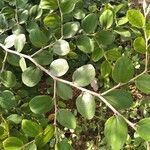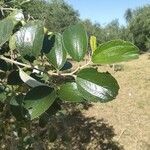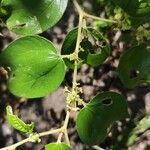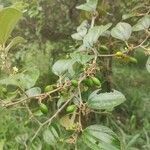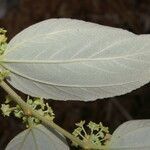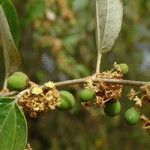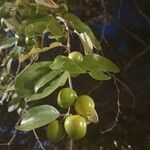Small tree, armed with spines on the older branches, the stems brown-tomen-tose. Leaves alternate, 3-nerved almost to the apex, oval to suborbicular, obtuse to retuse, finely crenate-serrate, each tooth with a small gland at the tip, obtuse to slightly rounded and weakly oblique basally, to 4.5 cm long and 3 cm wide, dull green and glabrous above, densely tomentose beneath, the pubescence on the veins brown; petioles ca. 5-8 mm long, brown-tomentose, the stipules un-equally developed, the longer ca. 2-3 mm long on older branches. Inflorescences cymes, axillary and sessile, 10-15-flowered. Flowers subsessile to shortly pedicel-late, the pedicels to 4 mm long, tomentose; floral tube shallowly patelliform; sepals (4-)5, deltoid, sometimes slightly unequal, ca. 1.2-1.5 mm long, glabrous and keeled within, tomentose without; petals (4-)5, clawed, white, ca. 1.2 mm long; stamens (4-)5, the filaments subulate, ca. 1 mm long, the anthers ca. 0.4 mm long; nectariferous disc ca. 10-ridged; ovary completely immersed in the disc, the style ca. 0.3-0.4 mm long, the stigmas 2, minute. Fruit unknown.
A medium sized tree. It is thorny. It loses many of its leaves during the year. It grows up to 10-12 m high. The bark is grey, brown or pale red. Branches and the under surface of the leaves are densely hairy when young. The thorns arise from the base of the leaves. The leaves are alternate and simple. They are finely toothed. They can be oval or round and 8 cm long by 5 cm wide. The flowers are green and have a scent. They occur as 3-5 flowers together. The flowers are 1-2 cm long and on slender branches. The fruit are small, oval and yellow or brown. They are sweet. They are 2-5 cm long and 2.5 cm wide. The fruit are green when young and turn yellow or brown when ripe. The pulp is fleshy, acid and edible. The fruit have one seed imbedded in the flesh in a hard stone. The fruit wrinkle on drying. Many varieties exist.
Shrubs or small trees, 3–10(–15) m; secondary branches white-silvery to grayish, becoming brown, tomentose, glabrescent, not thorn-tipped, axillary thorns absent; stipular spines usually present, straight or recurving, 2–3 mm, solitary or paired, sometimes absent. Leaves persistent, alternate; blade whitish to tawny abaxially, dark green adaxially, oblong to elliptic or elliptic-ovate, 2.5–8 cm, base obtuse to rounded, usually oblique, margins serrulate, apex rounded, abaxial surface tomentose, adaxial surface glabrous; 3-veined from base. Inflorescences cymes, 2–8-flowered. Flowers: hypanthium and sepals greenish to greenish white; petals white. Drupes ripening from yellow or orange to red or reddish brown, globose to ovoid or oblong, 20–30 cm. 2n = 24.
Shrub or tree 4–10 m high, with greyish-or rusty-tomentose stems, inflorescence axes and flowers. Leaves: lamina broadly ovate to broadly elliptic, (25–) 40–60 (–75) mm long, (15–) 25–40 (–60) mm wide, obtuse to cuneate base, finely serrulate (rarely entire) margin, obtuse apex, distinctly discolorous, green and glabrous above, grey-tomentose below; petiole (4–) 7–15 (–20) mm long; stipules 1–10 (–20) mm long. Pedicels 1–10 mm long. Hypanthium (1.7–) 2–3 (–4) mm diam. Sepals 1.4–2.2 mm long. Petals cucullate or longitudinally rolled, 1.4–2 mm long. Stamens 1.4–1.9 mm long. Disc ± smooth, glabrous. Ovary inferior; carpels 2; style 0.2–1 mm long. Fruit reddish brown to orange or purple, ellipsoid to globular, 13–24 mm long.
